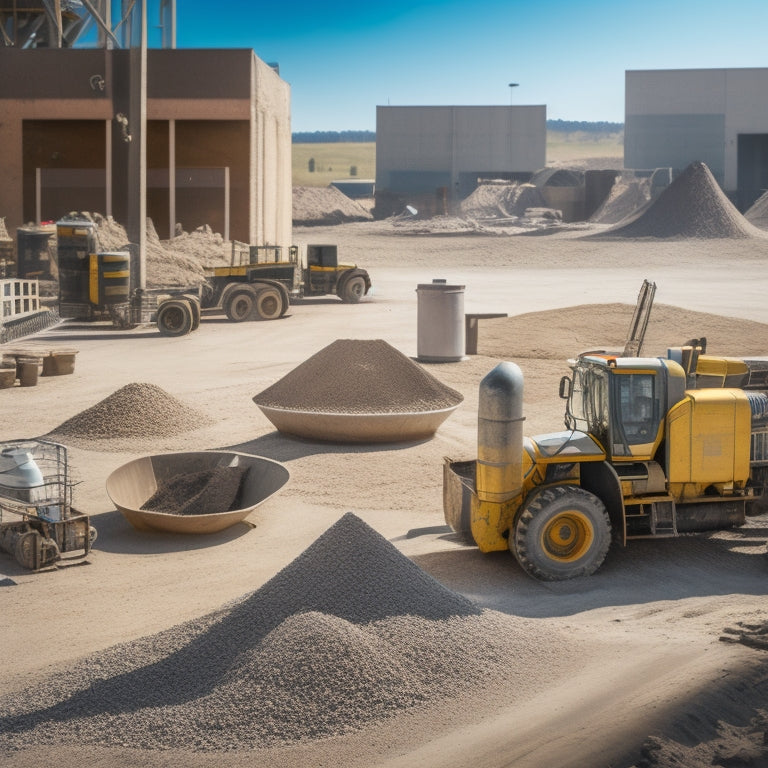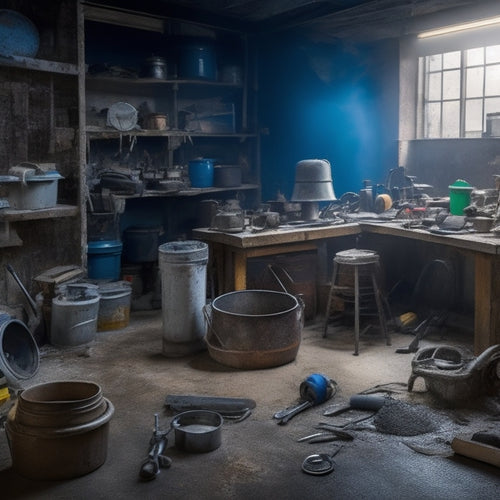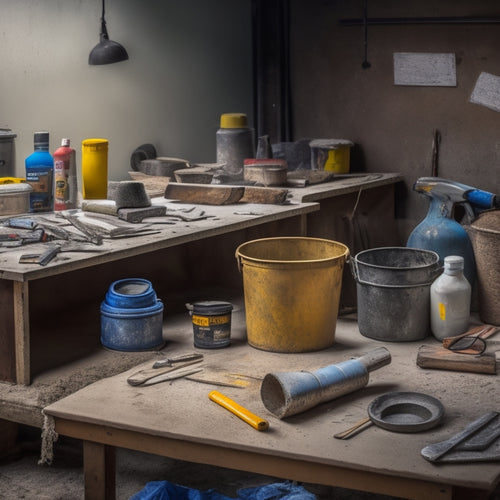
Why These Concrete Tools Are Always in Demand
Share
You rely on a set of trusted concrete tools to deliver high-quality results, and it's not surprising - these tools are crucial for achieving smooth finishes, consistent mixes, and precise edges that are critical to the structural integrity and aesthetic appeal of concrete structures. Your trowels, mixers, hand floats, edgers, leveling tools, and chisels help you achieve professional results by allowing you to work efficiently and accurately. From inspecting and maintaining your tools to using the right techniques, you know that each one plays a crucial role in your project's success. As you continue to refine your skills, you'll uncover the full potential of these must-have tools.
Key Takeaways
• Consistency and quality in concrete finishing are crucial, making these tools essential for achieving high-gloss finishes and smooth surfaces.
• The variety of concrete tools available caters to different project requirements, ensuring the right tool is always available for the job.
• Regular inspection, maintenance, and cleaning of tools prevent damage, prolong their lifespan, and ensure optimal performance.
• The versatility of these concrete tools allows them to be used in various applications, from edging to leveling, making them a valuable investment.
• The accuracy and precision provided by these tools are critical in ensuring structural integrity and aesthetic appeal in concrete constructions.
Trowels for Smooth Finishes
What type of trowel do you need to achieve a smooth, even finish on your freshly poured concrete slab?
When it comes to trowel types, you'll find that there are several options available, each designed for specific tasks. A finishing trowel, for instance, is ideal for achieving a high-gloss finish, while a pool trowel is better suited for curved or irregular surfaces.
Regardless of the type you choose, proper trowel maintenance is essential to guarantee peak performance and safety. Regularly inspect your trowel for signs of wear, such as bent or damaged blades, and replace them as needed.
Clean your trowel thoroughly after each use to prevent concrete from hardening on the surface. Store your trowel in a dry place to prevent rust and corrosion.
Concrete Mixers for Consistency
You'll need a reliable concrete mixer to produce a consistent batch of concrete, as inconsistent mixtures can lead to subpar finishes and compromised structural integrity.
There are several mixer types to choose from, including drum mixers, pan mixers, and twin-shaft mixers, each with its own strengths and weaknesses. When selecting a mixer, consider the size of your project, the type of concrete you're working with, and the level of precision you need.
To guarantee consistent results, it's essential to maintain your mixer properly. Regularly inspect the mixer's blades and drums for wear and tear, and replace them as needed.
Clean the mixer thoroughly after each use to prevent concrete buildup and contamination. Additionally, follow the manufacturer's instructions for lubricating the mixer's moving parts and performing routine maintenance tasks.
Hand Floats for Finishing Touches
By employing a hand float, you can achieve a smooth, even finish on your freshly poured concrete, which is critical for both aesthetic appeal and long-term durability. This essential tool allows you to remove excess water and air pockets, resulting in a strong and stable surface.
When choosing a hand float, consider the materials: magnesium or aluminum floats are lightweight and durable, while resin floats offer superior buoyancy and are ideal for finishing large areas.
To master hand float techniques, start by holding the float at a 45-degree angle and applying gentle pressure. Work in overlapping sections, using long, smooth strokes to spread the concrete evenly.
As you progress, adjust your angle and pressure to achieve the desired finish. Remember to always maintain a safe working distance and avoid over-working the concrete, which can lead to surface imperfections.
Edgers for Clean Lines
When creating clean lines and defined edges, edgers are the go-to tools for concrete finishers, allowing them to precisely shape and form the concrete to achieve a professional-looking finish.
As you work with edgers, you'll appreciate their versatility in creating various edger techniques, from simple to complex designs. Whether you're aiming for a subtle decorative edging or a bold, statement-making border, edgers provide the precision and control you need.
When choosing an edger, consider the type of concrete you're working with and the desired edge profile. For instance, a radius edger is ideal for curved edges, while a straight edger is better suited for sharp, clean lines.
Always follow safety guidelines when operating an edger, wearing protective gear such as gloves and safety glasses to prevent injuries.
Leveling Tools for Perfection
With clean lines and defined edges in place, it's time to focus on achieving a perfectly level surface using the right tools. You can't afford to compromise on precision alignment, as it directly affects the structural integrity and aesthetic appeal of your concrete project.
To guarantee accurate leveling, you'll need:
-
Laser levels: These precision instruments project a level line or plane, allowing you to identify even the slightest deviations from the desired plane.
-
Leveling rods: These versatile tools enable you to measure and transfer precise elevations across the project site.
-
Tamping tools: Designed for compacting and leveling, these tools help eliminate air pockets and guarantee a smooth, even finish.
Chisels for Removing Defects
When you're working with concrete, defects can be a major issue.
You'll likely need to remove flaking edges or repair cracked surfaces to guarantee a strong, durable finish.
To tackle these problems, you'll want to reach for the right chisels, which are designed to make precise, controlled cuts and remove defects efficiently.
Flaking Edge Removal
You'll often need to remove flaking edges from freshly poured concrete to prevent defects and guarantee a smooth finish, and that's where chisels come in. Flaking techniques are vital in edge maintenance, as they help eliminate weak points that can lead to cracks and other issues.
When removing flaking edges, it's important to use the right tools and techniques to avoid damaging the surrounding concrete.
Here are three key considerations to keep in mind:
-
Choose the right chisel: Select a chisel that's specifically designed for concrete and has a durable, heat-treated edge.
-
Use proper striking techniques: Hold the chisel at a 20- to 30-degree angle and strike it gently but firmly, using a controlled motion to avoid over-striking.
-
Work in small sections: Divide the flaking edge into smaller areas and focus on one section at a time, using a gentle sweeping motion to remove the flaking concrete.
Cracked Surface Repair
Frequently, cracked surfaces in freshly poured concrete require prompt attention to prevent further damage, and that's where chisels come into play, serving as an essential tool for removing defects and guaranteeing a smooth finish.
When you're working with concrete, you know that even the smallest cracks can lead to major issues down the line. That's why it's vital to address them promptly. With the right chisel, you can effectively remove defects, preparing the surface for further treatment.
In cracked surface repair, chisels are often used in conjunction with other techniques, such as crack injection, to fully restore the surface. This process involves injecting a specialized material into the crack to fill it, and then sealing the surface to prevent water or other substances from penetrating.
By using chisels to remove defects and prepare the surface, you can guarantee a strong bond between the old and new materials, resulting in a durable and long-lasting repair.
Remember to always follow safety protocols when working with chisels and concrete to prevent accidents and guarantee a successful outcome.
Frequently Asked Questions
What Safety Precautions Should I Take When Using Concrete Tools?
When using concrete tools, you should take vital safety precautions to prevent injuries.
Always wear protective gear, including gloves, safety glasses, and a dust mask.
Guarantee a stable work environment by securing loose clothing and removing tripping hazards.
Properly maintain your tools to prevent malfunction, and follow the manufacturer's instructions.
Additionally, keep a first aid kit nearby and have a plan in place for emergency situations, prioritizing tool safety and injury prevention.
Can I Use Concrete Tools for Other Construction Materials?
You're not alone in wondering if your trusty concrete tools can moonlight with other construction materials.
Think of it like a Swiss Army knife - versatile and adaptable.
In reality, many concrete tools can be used with alternative materials like mortar, plaster, or even epoxy-based composites.
This tool versatility is a game-changer, especially when working with materials that share similar properties or require similar techniques.
Just remember to always follow safety guidelines and manufacturer recommendations to guarantee a safe and successful project.
How Often Should I Clean and Maintain My Concrete Tools?
You should establish regular cleaning schedules for your concrete tools to prevent damage and guarantee peak performance.
Set aside time daily to wipe down tools with a damp cloth, and perform thorough cleaning every week.
Additionally, incorporate maintenance tips like lubricating moving parts, inspecting for wear, and storing tools in a dry area.
Are Concrete Tools Suitable for DIY Home Improvement Projects?
When tackling DIY project ideas, you'll find concrete tools are suitable for various tasks.
With proper concrete mixing techniques, you can achieve professional results.
For instance, using a concrete trowel, you can create smooth surfaces and patterns. Additionally, a concrete edger helps define borders and edges.
To guarantee success, always follow safety guidelines and manufacturer instructions.
Can I Rent Concrete Tools Instead of Buying Them?
You're wise to contemplate renting concrete tools instead of buying them, especially if you're a DIY enthusiast with limited storage space or a one-time project.
Renting offers several advantages, including access to a wide range of tool availability without the hefty upfront cost.
Plus, you won't have to worry about maintenance or storage when the project is complete.
Conclusion
As you stand on the battlefield of construction, your arsenal of concrete tools is your greatest ally.
Just as a master painter wields brushes to create a masterpiece, you wield trowels, mixers, hand floats, edgers, leveling tools, and chisels to craft a concrete canvas of perfection.
With each tool, you conquer imperfections, tame the raw materials, and bring order to the chaos.
Your concrete creation rises, a demonstration of your skill and precision, a fortress of strength and beauty that will stand the test of time.
Related Posts
-

7 Tools to Fix Damaged Concrete Floors
You're about to tackle that damaged concrete floor, and the right tools are essential for a successful repair. Start ...
-

3 Best Tools to Buy for Concrete Repair Online
When buying tools for concrete repair online, you'll want to research multiple retailer options to find the best prod...
-

Free Design Tools for Concrete House Planning
You can kick-start your concrete house planning project without breaking the bank, as there are several free design t...


